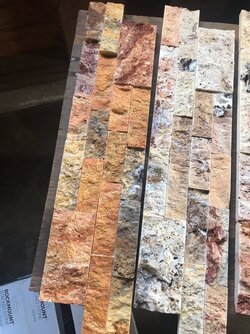I will first admit that this is not related to stoves or fireplaces, but rather a window well installation. Iv'e found it virtually impossible to get help from the stone veneer manufacturer. This forum has some fantastic stone masonry work so I was hoping for some help! I am applying thin stone veneer panels to a CMU window well. I am primarily concerned with how to seal it to prevent mildew since it will be in a shaded area all year round. The sealers I've tried (that claim they don't change the look of the stone) on test pieces really change the color. The panel on the left has a solvent based impregnating sealer applied, one coat, that was not supposed to change the color. The panel on the right has nothing applied and is the color I'm looking for. Any recommendations would be great, I am looking for no change whatsoever to the color. If this is not possible, is it possible to install with no sealer at all and just keep the stone clean with some kind of mild detergent? Any help would be greatly appreciated!



